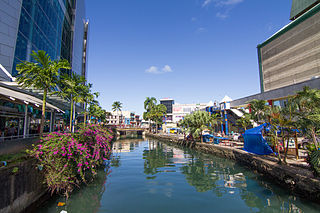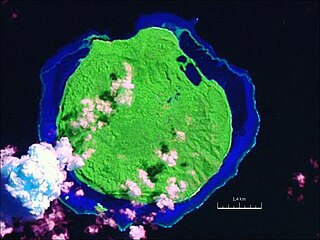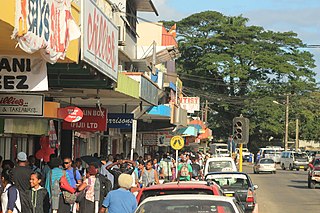Related Research Articles

The economy of Fiji is one of the most developed among the Pacific islands. Nevertheless, Fiji is a developing country endowed with forest, mineral and fish resources. The country has a large agriculture sector heavily based on subsistence agriculture. Sugar exports and the tourism industry are the main sources of foreign exchange. There are also light manufacturing and mining sectors.
CSR Limited is a major Australian industrial company, producing building products and having a 25% share in the Tomago aluminium smelter located near Newcastle, New South Wales. It is publicly traded on the Australian Securities Exchange. In 2021, it had over 3,000 employees and reported an after-tax profit of $146 million. The company has a diversified shareholding, with predominantly Australian fund managers and retail owners. The group's corporate headquarters is in North Ryde, Sydney.

Mago Island is a volcanic island that lies in the northwest sector of Fiji's northern Lau Group of islands. One of the largest private islands in the southwestern Pacific Ocean, the island has an area of 22 square kilometres (8.5 sq mi). The island is privately owned by actor/director Mel Gibson.

Nausori is a town in Fiji. It had a population of 57,866 at the 2017 census. This makes it the fourth most populous municipality in the country. Situated 19 kilometers outside of Suva, it forms one pole of the burgeoning Suva-Nausori corridor. Nausori is home to three provinces Rewa, Tailevu and Naitasiri.
The Harwood Sugar Mill is located on Harwood Island on the Clarence River in the Northern Rivers region in north-eastern New South Wales, Australia. It began operations in 1874, and is the oldest sugar cane crushing mill still operating in Australia. Harwood Mill is one of the three sugar mills in NSW with the other mills located at Condong on the Tweed River and Broadwater on the Richmond River.
Ayodhya Prasad Sharma was an Indo-Fijian farmers' leader and politician. He formed the most successful farmers' union in Fiji and forced the Colonial Sugar Refining Company to make concessions to farmers after 60 years of total control over Fiji's economy. However, other Indo-Fijian leaders formed rival unions and his initial success was not repeated. He also served as a member of the Legislative Council between 1953 and 1959.
Kisan Sangh was the first farmers' union formed in Fiji on 27 November 1937. This was the result of one man's determination to improve the plight of Fiji's Indian cane farmers. Ayodhya Prasad had arrived from India in 1929, and after a stint as a teacher took up cane farming and thus obtained firsthand experience of the problems faced by Fiji Indian cane farmers.
There have been numerous sugar cane farmers−growers trade unions in Fiji and in the preceding British Colonony of Fiji (1874−1970).
The Southern Division Kisan Sangh was formed in Fiji in 1946 by a former member of parliament, K. B. Singh, due to personal differences with the president of the Rewa Planters Union, Ram Krishna Chaudhary. There was widespread opposition to this until Vishnu Deo took over its leadership and worked together with Ram Krishna Chaudhary and his union.
Fiji Sugar Corporation (FSC) is the government-owned sugar milling company in Fiji having monopoly on production of raw sugar in Fiji. It is also the largest public enterprise in the country employing nearly 3,000 people, while another 200,000 or more depend on it for their livelihood in rural sugar cane belts of Fiji.
Sir Sathi Narain KBE was a Fiji Indian businessman who built a construction and shipping business.
Rail transport in Fiji moves cut sugar cane to crushing mills. Also, there used to be two horse-drawn street tramway systems, some other passenger systems, an underground mine system, and some tramways on construction projects. There are multiple other modes of transport in Fiji.
This is a synopsis of organisations formed by Indians in Fiji. When they became free from the bondage of indenture and were able to organise themselves, they founded numerous organizations to seek social and political justice. These organisations promoted the teaching of Indian languages and religious practices and also to help others in time of need. Some of the successful organisations are listed below in the order in which they were established. Some, such as the National Federation Party, are no longer exclusively Indian, but are still predominantly so.
Sugar cane grew wild in Fiji and was used as thatch by the Fijians for their houses (bures). The first attempt to make sugar in Fiji was on Wakaya Island in 1862 but this was a financial failure. With the cotton boom of the 1860s there was little incentive to plant a crop that required high capital outlay but after a slump in cotton prices in 1870, the planters turned to sugar. In an effort to promote the production of sugar in Fiji, the Cakobau Government, in December 1871, offered a 500-pound reward for the first and best crop of twenty of sugar from canes planted before January 1873.
The Penang Sugar Mill in Rakiraki, Fiji was one of the four sugar mills operated by the Fiji Sugar Corporation. The FSC is the sole producer of raw sugar in Fiji.
The Colonial Sugar Refining Company built a mill at Viria, on the Rewa River, on the southern side of the island of Viti Levu on Fiji. It crushed from 1886 to 1895 and was closed because it was too small to be viable. Sugarcane grown along the Waidina river was transported by rail to the Viria mill through a tunnel in a nearby hill range.
CSR Yarraville is an operating sugar refinery at Whitehall Street, Yarraville, City of Maribyrnong, Victoria, Australia. It was built from 1872 to 1980s. It is also known as Colonial Sugar Refining Company Refinery of Yarraville. It was added to the Victorian Heritage Register on 21 October 1992.

Habana Tramline Causeway and Wharf Site is a heritage-listed causeway between Habana Wharf Road and Constant Creek, Habana, Mackay Region, Queensland, Australia. It is also known as Habana Wharf Road. It was added to the Queensland Heritage Register on 14 May 2010.

Fairymead Sugar Plantation was a sugar plantation in Fairymead, Bundaberg Region, Queensland, Australia. It was established by Ernest Young together with his father Henry and brothers Arthur, and Horace. It was one of Bundaberg's earliest independent sugar plantations and had one of its earliest sugar mills.
References
- ↑ FIJI: Handbook of the Colony, Government Printer, Suva, 1936, p. 65
- M. Moynah, Brown or white? A history of the Fiji sugar industry 1873 – 1973, Australian National University, 1981